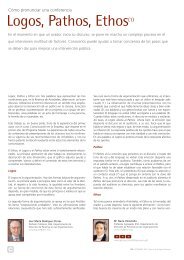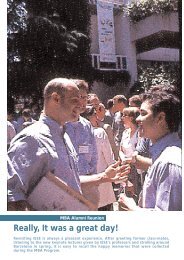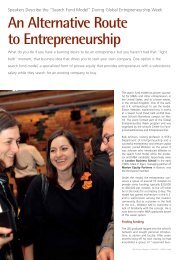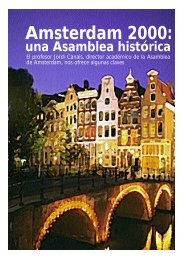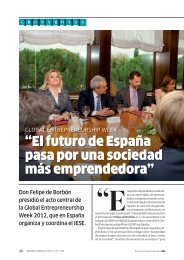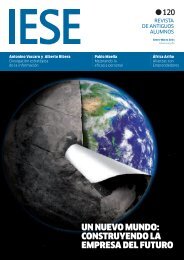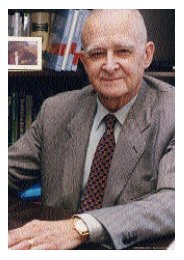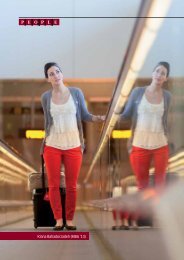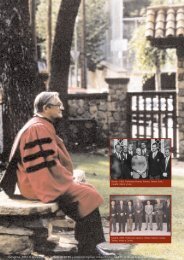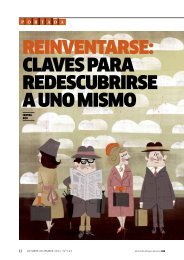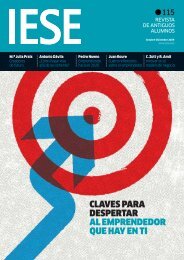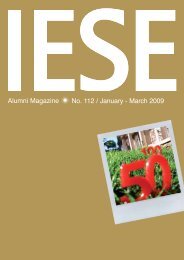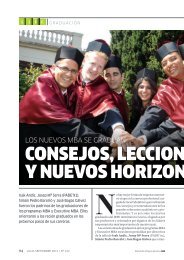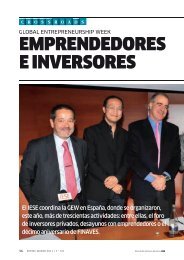50 years of gratitude
50 years of gratitude
50 years of gratitude
You also want an ePaper? Increase the reach of your titles
YUMPU automatically turns print PDFs into web optimized ePapers that Google loves.
A PRACTICAL CASE STUDY: WHAT IS IESE'S SECRET?<br />
<strong>50</strong> YEARS OF GRATITUDE<br />
Pedro Nueno, Pr<strong>of</strong>essor <strong>of</strong> Entrepreneurship, IESE<br />
If you achieve something difficult, it is only fair to thank those<br />
who made it possible. There are hundreds <strong>of</strong> people who have<br />
generously contributed their efforts and enthusiasm to help build<br />
the outstanding institution that IESE is today. This article is a small<br />
tribute to all <strong>of</strong> them.<br />
IESE Alumni Magazine / OCTOBER – DECEMBER 2008<br />
77
"WE ALSO MANAGED TO FORGE ALLIANCES WITH INSEAD, LBS AND OTHER LEADING<br />
BUSINESS SCHOOLS IN EUROPE TO JOINTLY ORGANIZE PROMOTIONAL EVENTS UNDER THE<br />
SLOGAN 'YOUR MBA IN EUROPE'."<br />
My first contact with IESE was back in 1968,<br />
ten <strong>years</strong> after its foundation. Everyone<br />
I have taught in recent <strong>years</strong> will have<br />
heard me say “nostalgia devaluates us as<br />
people.” We should focus on the future<br />
instead. But if there is anything <strong>of</strong> value<br />
in looking to the past, it is <strong>gratitude</strong>. If you achieve a difficult<br />
goal, it is fair to thank those who made it possible. And this<br />
sort <strong>of</strong> <strong>gratitude</strong> is not exactly a dime a dozen. IESE’s outstanding<br />
success is the fruit <strong>of</strong> many people’s ideas and their<br />
capacity to turn them into reality, and I would like to <strong>of</strong>fer a<br />
few words <strong>of</strong> <strong>gratitude</strong> to some <strong>of</strong> them here.<br />
On my first visit to IESE, Pr<strong>of</strong>. Lorenzo Dionis showed me the<br />
small campus and told me, among other things: “One day<br />
we’ll be teaching the MBA program in English.” I couldn’t<br />
speak English, and that really impressed me. I was hired as a<br />
research assistant to Pr<strong>of</strong>. Miguel Á. Gallo. I could become a<br />
pr<strong>of</strong>essor if I earned a doctorate degree in the United States. I<br />
left a better-paying job to try and make that dream come true.<br />
A few days after I was hired, Pr<strong>of</strong>. Dionis introduced me to<br />
Pr<strong>of</strong>. Félix Huerta, whose <strong>of</strong>fice was next door. He insisted on<br />
the issue <strong>of</strong> English and the U.S. doctorate as prerequisites for<br />
my making it at the school. Years later, with a Ph.D. from Harvard<br />
under my belt and prematurely appointed associate dean<br />
by that incredible boss, Pr<strong>of</strong>. Fernando Pereira, I submitted<br />
a proposal to the board that IESE <strong>of</strong>fer the MBA program in<br />
English, the goal shared by Pr<strong>of</strong>s. Dionis and Huerta.<br />
Pr<strong>of</strong>. Harald Burmeister was even more enthusiastic than I<br />
was and spurred me on. The Harvard-IESE Committee was<br />
in stitches at the idea, though. “IESE should be the leading<br />
Spanish-speaking school in the world; you don’t need to dabble<br />
in English.” I naively pointed out that if we managed to be<br />
the leading school in the English-speaking world, we would<br />
also be the leading school in the Spanish-speaking world.<br />
Pr<strong>of</strong>s. Pereira, Pérez López, Faus and Sanllehí, all board members,<br />
gave the green light. There would be two tracks, one in<br />
English and the other in Spanish, because some <strong>of</strong> the pr<strong>of</strong>essors<br />
with clout were not about to learn English. In 1980, IESE<br />
began <strong>of</strong>fering the world’s premier bilingual MBA program.<br />
IESE’s dean at that time, Pr<strong>of</strong>. Juan A. Pérez López, told me,<br />
“Now, you will be in charge <strong>of</strong> selling this because we cannot<br />
afford to fail. I’ll teach all the classes I have to in English.” We<br />
hired Nicola Hijlkema, an Estonian who left the London Business<br />
School (LBS) to help IESE in that reckless venture.<br />
We also managed to forge alliances with INSEAD, LBS and<br />
other leading business schools in Europe to jointly organize<br />
promotional events under the slogan “Your MBA in Europe.”<br />
We drew audiences <strong>of</strong> 300 or 400 candidates in cities including<br />
London, Paris, Munich, Brussels, Madrid, New York and<br />
San Francisco. Each school took a speaker, an alum and a<br />
senior manager, to sell the idea <strong>of</strong> “Your MBA in Europe” (and<br />
indirectly their own school).<br />
In Paris I convinced Jaume Llopis, then managing director <strong>of</strong><br />
Moulinex, one <strong>of</strong> France’s most famous companies, to come<br />
with me. I chose Llopis, now pr<strong>of</strong>essor in the Department<br />
<strong>of</strong> Strategic Management, because I thought that he was a<br />
good salesman and everyone knew Moulinex. Llopis sold me<br />
a microwave oven on the way there and another on the way<br />
back. I don’t know how he did it. The one that works really<br />
well still survives in my country house.<br />
When MBA alumni sit next to me on a plane, I ask them what<br />
they sell and when they’re coming back. But I want to avoid<br />
falling into the same trap I fell into with Llopis. My affection<br />
for our alumni and their skill as salespeople does not convince<br />
me to buy, say, a truck on the way there and another on the<br />
way back!<br />
From those promotional trips, portable stand in hand, I fondly<br />
remember a pregnant Andrea Christensen (MBA ’83) helping<br />
out with her enterprising energy in Munich. Christensen, CEO<br />
and president <strong>of</strong> the doll, toy and children’s fashion company,<br />
Käthe Kruse Puppen, is now a member <strong>of</strong> IESE’s International<br />
Advisory Board.<br />
I remember another early IESE alumna, Teresa Gener (MBA<br />
’86) enthusiastically manning the booth at an event in Brussels.<br />
Gener is now the school’s director <strong>of</strong> human resources.<br />
And another graduate <strong>of</strong> the MBA class <strong>of</strong> ’86, Pedro Goenaga,<br />
came to help us sell the program in San Francisco while on<br />
exchange at The Wharton School in Pennsylvania. Goenaga<br />
is now partner in Russell Reynolds Associates and head <strong>of</strong><br />
its Spain <strong>of</strong>fice.<br />
Our first courageous MBA graduates deserve our <strong>gratitude</strong> for<br />
placing their trust in IESE. Then the time came to “sell” them<br />
to the market. Pérez López reminded me bluntly: “We have to<br />
place our products.” I decided to go to Wall Street. Why not<br />
start at the top? I don’t know what I must have said to some<br />
Harvard colleague to open the door to JPMorgan, but there<br />
I went, and I didn’t have to fake my enthusiasm.<br />
This leads me to express another debt <strong>of</strong> <strong>gratitude</strong>, this time<br />
to Cynthia Muller (today with Morgan Stanley in London),<br />
who took the bait. I couldn’t believe it. Job <strong>of</strong>fers for our MBA<br />
graduates in New York, on Wall Street. Today it’s common, <strong>of</strong><br />
course. But what happened next is truly worth remembering.<br />
In 1978, Deng Xiaoping, then leader <strong>of</strong> China’s communist<br />
party, decided to open up the country’s economy. So, in 1979,<br />
Pr<strong>of</strong>. Dionis went there and again in 1980 to organize the first<br />
78 IESE Alumni Magazine / OCTOBER – DECEMBER 2008
"IESE HAS TO BE ONE OF THE SCHOOLS WITH THE GREATEST AFFECTION FOR ITS ALUMNI.<br />
YOU COULD ALREADY TELL THIS JUST BY WALKING INTO THE SCHOOL ALMOST 40 YEARS AGO.<br />
PEOPLE ALWAYS COMMENTED ON IT."<br />
program in China for IESE alumni. Pr<strong>of</strong>s. Roig and Dionis identified<br />
the opportunity that China is today 30 <strong>years</strong> ahead <strong>of</strong><br />
time (see page 12 <strong>of</strong> the first issue <strong>of</strong> IESE’s Alumni Magazine,<br />
1980). If there are gurus today stating that the world isn’t flat,<br />
what must it have been like back then?<br />
ONE OF THE FAMILY<br />
IESE has to be one <strong>of</strong> the schools with the greatest affection<br />
for its alumni. You could already tell this just by walking<br />
around the school almost 40 <strong>years</strong> ago. People always commented<br />
on it. But Pr<strong>of</strong>. Pereira was the one who organized it,<br />
like so many other things, when he had to bring order to that<br />
orgy <strong>of</strong> entrepreneurship that was IESE.<br />
In 1977, Catalonia’s regional government, the Generalitat de<br />
Catalunya, was reestablished with Josep Tarradellas at the<br />
helm. “You’re Catalan, so go there and tell this gentleman<br />
what IESE is,” Pereira ordered me. And <strong>of</strong> course I went, but<br />
I took three alumni along with me: Francisco Sanllehí, a great<br />
businessman who was our general secretary and helped in<br />
admissions, along with Alberto Parera and Luis M. Roger,<br />
president and vice president <strong>of</strong> the Alumni Association respectively.<br />
Parera, Roger and Sanllehí were always willing to help<br />
any way they could.<br />
We went to the Palau de la Generalitat, the seat <strong>of</strong> the Catalan<br />
government, and explained IESE’s mission to President<br />
Tarradellas in Catalan and invited him to the Alumni Assembly<br />
a few weeks later. President Tarradellas came to the assembly<br />
and was seated at the head table next to Pr<strong>of</strong>s. Pereira, Sanllehí,<br />
Parera, Roger and myself.<br />
He took in the atmosphere and whispered to me, “I was going<br />
to say a few words, but this is an extremely moving event and<br />
they want to listen to Mr. Pereira.” He limited himself to congratulating<br />
the participants, telling them that he was proud<br />
that there was an institution like IESE in Catalonia, and then<br />
gave the floor to Pr<strong>of</strong>. Pereira.<br />
He was rewarded with a robust round <strong>of</strong> applause from an<br />
audience with many people from other regions in Spain. Economics<br />
Pr<strong>of</strong>essor Juan J. Toribio, now at IESE’s Madrid campus<br />
had brought Enrique Fuentes Quintana, the intellectual<br />
author <strong>of</strong> the Spanish tax reforms <strong>of</strong> 1978, to tell us about<br />
the Moncloa Pacts. The Moncloa Pacts were agreements made<br />
between the government, political parties and trade unions<br />
that were intended to create the conditions necessary for the<br />
consolidation <strong>of</strong> democracy.<br />
FACULTY SUPPORT<br />
The day I was named associate dean <strong>of</strong> IESE in 1978 I got<br />
two surprises: one worrisome and the other encouraging. The<br />
troublesome one was the school’s financial situation. There<br />
were times when money was so tight at IESE that it needed<br />
bridging loans to cover payroll for a few months until the<br />
tuition fees from the next graduating class came in.<br />
Some banks and savings and loans institutions believed in<br />
IESE, like the Caja de Barcelona, which had not yet merged<br />
into “la Caixa.” We owe Eusebio Díaz-Morera, head <strong>of</strong> Caja<br />
de Barcelona at that time, a huge debt <strong>of</strong> <strong>gratitude</strong> for trusting<br />
in IESE during those difficult times.<br />
And the surprise that bolstered my spirits was finding out<br />
about the financial support that the pr<strong>of</strong>essors gave IESE. During<br />
its first quarter century, the school’s faculty contributed<br />
part <strong>of</strong> their salaries to ensure the institution’s survival. That is<br />
momentous motivation.<br />
We had a moral pact with IESE to donate 25 percent <strong>of</strong><br />
our income from consultancy or membership on company’s<br />
boards. There were pr<strong>of</strong>essors like Leopoldo Abadía, Miguel<br />
Á. Gallo, Juan Farrán, José A. Mustienes and Lorenzo Dionis<br />
who donated the equivalent <strong>of</strong> their IESE salary or more.<br />
Yet there were also young pr<strong>of</strong>essors like Vázquez-Dodero,<br />
Velilla and Lucas who must have cheated and given more<br />
than 25 percent. Isn’t that worth our <strong>gratitude</strong>? How can we<br />
repay such outstanding men including José M. Rodríguez, José<br />
Ocáriz, Pere Agell, Fernando Pereira and others like them for<br />
their generosity? Many people aren’t even aware <strong>of</strong> their crucial<br />
contribution to the school today.<br />
I have certainly failed to mention many people who deserve<br />
our <strong>gratitude</strong>, but what comes to mind are the many Harvard<br />
pr<strong>of</strong>essors who generously supported both IESE and the international<br />
projects that IESE embarked on in Latin America from<br />
its earliest days. In 1971, three recent MBA graduates showed<br />
up at my house in Cambridge, Massachusetts, led by Manolo<br />
Casas (MBA ’71), now with the Santander banking group in<br />
France.<br />
I was a poor and fragile doctoral student at Harvard with dim<br />
chances <strong>of</strong> survival. "We’ve graduated from IESE and we’ve<br />
come to Harvard to get our degrees validated here. What<br />
<strong>of</strong>fice do we have to go to?" I was dumbfounded. For many<br />
Harvard pr<strong>of</strong>essors, IESE meant nothing to them. But I went<br />
with them to the <strong>of</strong>fice <strong>of</strong> Frank Folts, a retiree but the man<br />
who launched Harvard’s first executive education programs<br />
(until World War II, Harvard only <strong>of</strong>fered an MBA).<br />
Folts did know about IESE and was a big fan <strong>of</strong> the founders’<br />
work. He wrote them a letter on "Harvard letterhead", which<br />
carried far more weight than a validation <strong>of</strong> their degrees.<br />
Ralph Hower, Charles Christenson, Harry Hansen (who spent<br />
a year at IESE), Wickham Skinner, Richard Dooley, Robert Sto-<br />
IESE Alumni Magazine / OCTOBER – DECEMBER 2008<br />
79
"THERE ARE HUNDREDS OF PEOPLE WHO<br />
GENEROUSLY CONTRIBUTED THEIR EFFORTS,<br />
ENTHUSIASM, IDEAS, INFLUENCE AND MONEY<br />
TO BUILD THE OUTSTANDING INSTITUTION THAT<br />
IESE IS TODAY."<br />
baugh and so many other Harvard pr<strong>of</strong>essors generously supported<br />
IESE, in contrast to the gurus <strong>of</strong> today who state their<br />
fees before they even let you talk.<br />
Soon after he earned his MBA in 1977, Juan C. Grijelmo<br />
managed to launch a PADE general management program in<br />
Bilbao, and Juan M. Elorduy, who had been in the Spanish<br />
government during the 19<strong>50</strong>s, went to lead it. Those were<br />
difficult <strong>years</strong> in Spain’s transition to democracy, and more<br />
than one <strong>of</strong> the program’s participants in the Basque Country<br />
had received threats.<br />
During those tumultuous <strong>years</strong> <strong>of</strong> Spain’s transition to democracy,<br />
IESE launched its MBA in English, its Executive MBA in<br />
Madrid, many programs and schools in Latin America, AESE<br />
in Portugal, the Instituto San Telmo in Seville and a host <strong>of</strong><br />
programs in cities around Spain. This was perhaps one <strong>of</strong> the<br />
most practical lessons in leadership.<br />
There are hundreds <strong>of</strong> people who generously contributed<br />
their efforts, enthusiasm, ideas, influence and money to build<br />
the outstanding institution that IESE is today. Hopefully we<br />
will set the record straight in a book one day. And Pr<strong>of</strong>. Josep<br />
M. Rosanas’s idea <strong>of</strong> producing this special edition <strong>of</strong> the IESE<br />
Alumni Magazine, helps us to express our <strong>gratitude</strong> to some<br />
<strong>of</strong> those who made it possible for us to be celebrating <strong>50</strong><br />
<strong>years</strong> <strong>of</strong> IESE.<br />
IESE Alumni Magazine / OCTOBER – DECEMBER 2008



